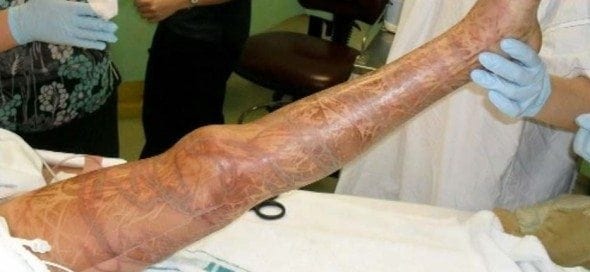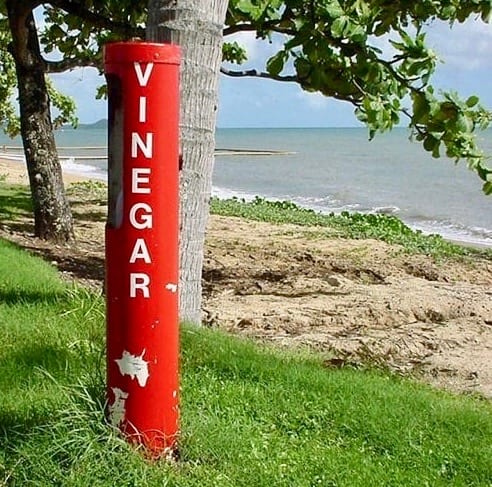Box Jellyfish (Chironex fleckeri)
Box Jellyfish
The box jellyfish is found in tropical Australian waters. Most stings are benign and respond to supportive measures. Severe envenoming has been associated with at least 67 deaths in Australia, the last 12 being children. All deaths occur within 5 minutes of the sting, probably secondary to direct cardiac toxicity.

Toxin
The specific venom components are still being identified. They are thought to affect sodium and calcium channels leading to abnormal membrane ion transport.
Clinical presentation and course
- Stings are associated with immediate severe pain, typically lasting up to 8 hours, and linear welts, which characteristically occur in a crosshatched pattern
- In 25-30% of cases the jellyfish tentacles are still adherent
- Systemic envenoming is heralded by collapse or sudden death within a few minutes of the sting
- Cardiovascular effects include hypertension, hypotension, tachycardia, impaired cardiac contraction and arrhythmias
- Delayed hypersensitivity reactions occur in at least 50% of patients and manifest as pruritic erythema at the original sting site, 7-14 days after the sting.


Management
- Reassure the patient, apply an ice pack and give simple oral analgesia such as paracetamol
- Apply generous volumes of vinegar (acetic acid) to all visible sting sites to inactivate all undischarged nematocysts (sting cells)
- Do not apply a pressure immobilisation bandage (PIB) as this may promote systemic envenoming
- Transport all patients with pain refractory to first‑aid, or systemic symptoms, to a medical facility

- Rarely, box jellyfish envenoming is a life‑threatening emergency
- Patients should be managed in an area equipped for cardiorespiratory monitoring and resuscitation
- Potential early life‑threats that require immediate intervention include cardiac arrest, hypotension or hypertension and cardiac arrhythmia
- In cardiac arrest, undiluted antivenom, administered as a rapid IV push, may be life‑saving. All immediately available Box Jellyfish antivenom (up to 6 ampoules) should be given. Intravenous magnesium (10 mmol) should be given if there is no response to antivenom
- Give titrated morphine (0.1 mg/kg IV up to 5 mg every 10 minutes) to patients with pain refractory to first‑aid
- Give three ampoules of Box Jellyfish antivenom (3 × 20,000 units) IV diluted in 100 mL normal saline over 20 minutes to all patients with systemic envenoming as evidenced by collapse, hypotension or significant cardiac arrhythmia. The patient is observed closely for response to treatment and ongoing features of envenoming prompt a further dose of antivenom (up to three ampoules)
- Give one ampoule (1 × 20,000 units) for pain refractory to IV opioid analgesia
Differential diagnosis
- Bluebottle stings (Physalia species) are also associated with immediate pain and dermal markings. Pain usually resolves within 1 hour and systemic symptoms are extremely rare
- Pain associated with Irukandji syndrome is usually delayed, severe and generalised. Significant linear dermal markings or welts are not seen
- Decompression illness may lead to severe pain and collapse shortly after a diver has surfaced. Local pain and welts are not seen
Handy tips
- Reassurance is important. Despite its reputation, the vast majority of box jellyfish stings require only first‑aid
- A steroid or antihistamine cream may provide symptomatic relief if a delayed hypersensitivity rash occurs
- Immediate pain after a jellyfish sting, occurring in shallow tropical waters between November and April, associated with linear welts with a cross‑hatched pattern, is pathognomonic of Chironex fleckeri sting
- Pressure immobilisation bandaging for box jellyfish stings has now been abandoned because direct pressure over tentacles leads to increased venom release from nematocysts
- Ice is currently recommended as appropriate first‑aid. It is possible that heat is more effective
If you’ve read this far, you’re ready for Toxicology Conundrum 010
References
- Bastian Bentlage, Paulyn Cartwright, Angel A. Yanagihara, Cheryl Lewis, Gemma S. Richards and Allen G. Collins.Evolution of box jellyfishes (Cnidaria: Cubozoa), a group of highly toxic invertebrates. Proceedings of the Royal Society, November 18, 2009 DOI:10.1098/rspb.2009.1707
- Hartwick R, Callanan V, Williamson J. Disarming the box-jellyfish: nematocyst inhibition in Chironex fleckeri. Med J Aust. 1980 Jan 12;1(1):15-20. [PMID 6102347]
- 10 year old girl survives box jellyfish attack [Guardian 2010][CNN 2010]
- Survival stories from box jellyfish [The Chronicle 2010]

Toxicology Library
TOXINS

Thanks for the article mate!
„Give three ampoules (3 × 20,000 units) IV diluted in 100 mL normal saline over 20 minutes“ – what medication?
Box Jellyfish antivenom